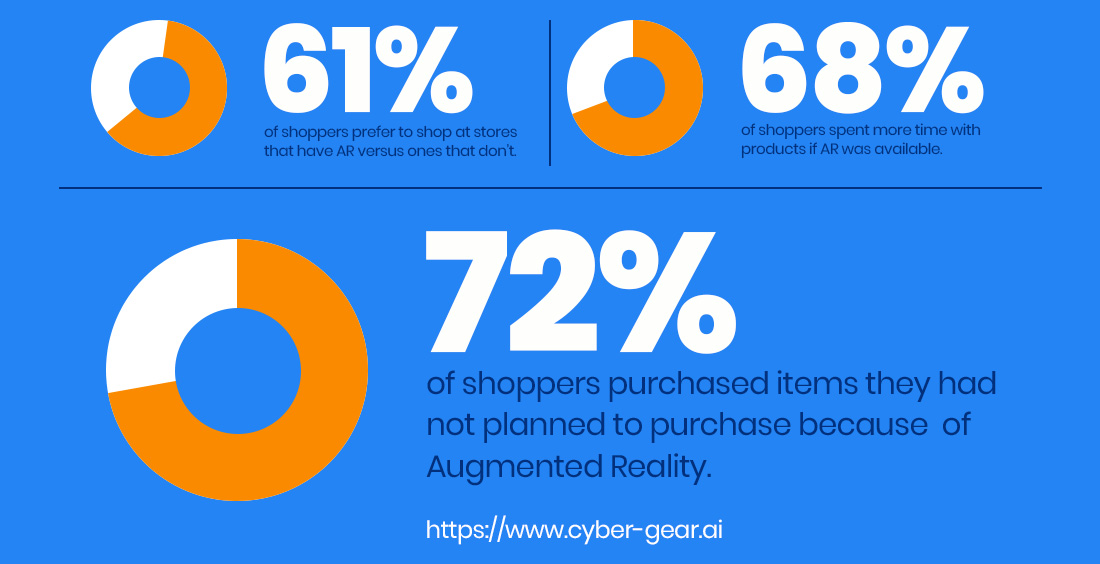Consumers will operate in a reality that is consistently enriched with virtual content, and marketers need to find ways to integrate these new realities into their marketing strategies.
With the launch of Apple’s ARKit and Google’s ARCore, augmented reality is no longer a future possibility for retail. It is happening now! Infact, 75% of consumers in the US now expect retailers to offer an augmented reality experience. Brands that take advantage of augmented reality will be the brands that satisfy more customers long-term.
The advantages of using AR in retail are many:
• Engage customers
• Visualize purchases in context
• Improve customer satisfaction and reduce returns
• Personalize the shopping experience
• Provide self-service store navigation
• Create content for social media
There are some specific AR solutions that are now available locally, right here in the Middle East.
1. Virtual Tryroom
Some multinational sports and beauty are already using augmented reality, image-recognition, and computer vision technology to convert the real world into a content-rich, interactive experience. Lacoste’s LCST Lacoste AR app allows customers to virtually try on shoes at the comfort of their home. Since its release last year, over 30,000 users have interacted with the products within the app. Sephora has created a Virtual Artist App with Modiface to show Sephora app users how makeup products will look on their face via their phone’s camera. By offering a comparable alternative to the in-store experience, brands can appeal to a larger demographic audience globally.
2. 3D Experience
AR is revolutionising the way we shop by bridging the gap between digital and physical worlds. A radical store re-invention offers retailers new ways to increase convenience and personalisation, and consumers the opportunity to experience re-envisioned shops. IKEA, Macy’s and Houz allow their customers to virtually position products in their home to see how they look, before making the purchase. Home Depot released its Project Color app, which allows users to see how a paint color looks in a room. The AR technology considers lighting, objects, and shadows in the room, so you can get a realistic portrayal of how the paint color will look in real life.
3. ‘Mobile First’ Strategy
Almost 60% of shoppers look up product information and prices while using their mobile phones in stores. Augmented reality can provide a critical solution for meeting those shoppers’ needs. American Apparel has created an AR app that allows customers to scan signs in-store and pull up product information, including customer reviews, color options, and pricing. Augmented reality helps bridge the gap between offline and online shopping, creating a more seamless and engaging experience. As many as 75% of consumers now expect retailers to offer an augmented reality experience.
4. AR in e-Commerce
AR-Watches app by ARLOOPA features super-realistic 3D models to allow customers to try on their favorite watches, find out their right fit in terms of size and style and feel confident before adding the items into their shopping carts. The app also allows customers to take photos, share and compare watches with friends on social media. The JARIT augmented reality application from ARLOOPA, allows users to preview their potential order in 3D. Designed specifically for the food industry, JARIT enables its partner restaurants to make their products more attractive to their customers through mouth-watering visualizations of the dishes.
A survey of 1,062 shoppers across the USA by the retail research firm Interactions Consumer Experience Marketing, Inc. provided some insight about the impact of AR in retail. By 2020, AR is expected to generate $120 billion in revenue, so there is an incentive to adopt some form of AR.
The research also found:
• 77% of shoppers want to see product features like colors or style
• 71% of shoppers would shop at a retailer more often if it had AR
• 65% want product information through AR
• 61% of shoppers prefer to shop at stores that have AR versus ones that don’t
• 55% say AR makes shopping fun
• 40% of people willing are to pay more for a product if they can experience it first through AR
Brands that use AR to sell products online will set themselves apart as especially innovative and modern. Augmented reality is clearly an important part of the future of retail and brands need to embrace the technology to survive and stay relevant. Period.



Comments are closed.